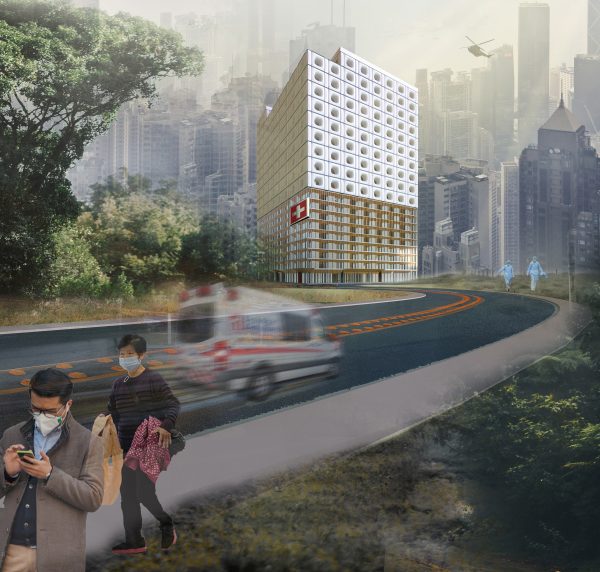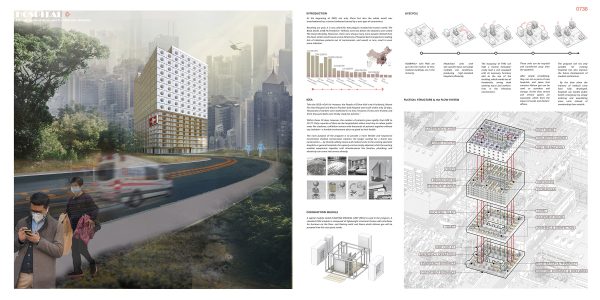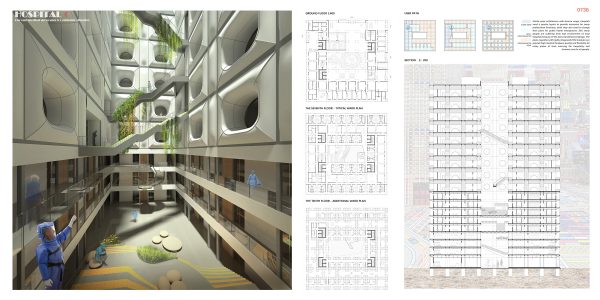Editors’ Choice
2020 Skyscraper Competition
Xinran He, Yiqiao Wang
China
INTRODUCTION
At the beginning of 2020, not only China but also the whole world was overshadowed by a severe biohazard caused by a new type of coronavirus.
Recalling our past, it is not unfamiliar that plagues invaded the human world: The Black Death, 1918 Flu Pandemic…Millions were lost before the disasters were called The Great Mortality. Moreover, there were always many more people infected than the dead, which would cause severe deficiency of hospital bed arrangement, leading lots of infectious patients out of containment, and would, in turn, result in even more infection.
Take the 2019-nCoV for instance: the People of China didn’t wait fruitlessly, Mount Fire God Hospital and Mount Thunder God Hospital were built within only 10 days. Thousands of workers were mobilized in no time, hectares of sites were leveled, and three thousand beds were finally ready for patients…
Within these 10 days, however, the number of patients grew rapidly from 549 to 11177. Only a quarter of them can be hospitalized, others must stay in indoor public areas like stadiums, exhibition centers with thousands of patients together without any isolation—a humble environment does no good to their health.
SOLUTION
The main purpose of the program is to provide a more flexible and responsive incremental medical construction solution. No longer waiting for a brand new construction — by directly adding rooms and medical units to the existing specialist hospitals or general hospitals, the capacity can be simply adjusted, while the existing medical equipment, together with infrastructures like location, plumbing, and electricity can come into service directly.
FLOATING MEDICAL UNIT
A typical module called FLOATING MEDICAL UNIT (FMU) is used in the program. A standard FMU module is composed of lightweight structural frames with interfaces for furniture on the floor, and floating walls and floors which Helium gas will be pumped into the vast space inside. Thus, the buoyancy of Helium will take over half of the gravity load, giving more capacity to the underneath construction, and finally increase the FAR of the hospital. The horizontal load will be undertaken by stay cables.
In addition, the buoyancy of FMU can help a normal helicopter easily load a unit equipped with all necessary furniture add to the top of the building, which avoids lots of handworks, saving both working hours and workers’ lives in the infectious environment.
After the epidemic, FMUs can be recycled and transferred away. After simple remodeling, they can act as parts of new hospitals, and space that contains Helium gas can be used as corridors and storage. At this time, served and servant spaces are separated, which frees the layout of wards and doctors’ offices.
FULL LIFE CYCLE DESIGN
The program will not only suitable for existing hospitals but also improve the future development of medical architecture. Modulized units with site-specific bases will adapt multiple site conditions, producing high-standard hospitals efficiently. By the time when the industry of medical units have fully developed, hospitals can handle public health emergency by simply ordering and assembling more units instead of constructing from scratch.
HOSPITALS IN FUTURE
Unlike most architecture with diverse usage, hospitals need a precise layout to provide assurance for many professional functions, while they also need to change their plans for public health emergencies. Still, many people are suffering from the bad environment of local hospitals because of the lack of professional design. The plans, together with highly integrated FMU modules can provide high medical hardware quality and flexibility for many pieces of land, ensuring fair hospitality and humane care for all people.

















